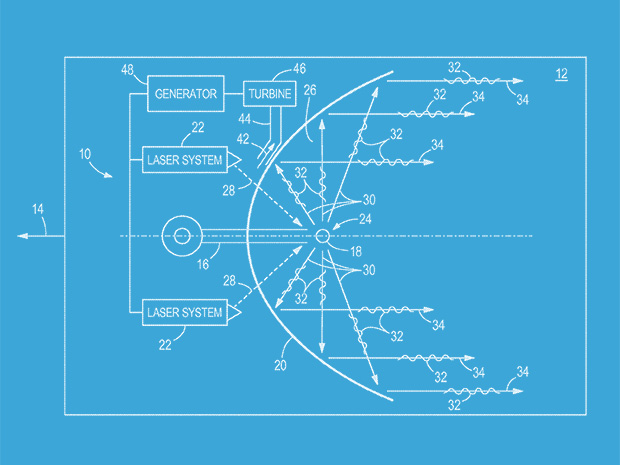I have mentioned in previous blogs that attempts were made to design nuclear powered aircraft during the Cold War. Both the U.S. and the U.S.S.R. considered nuclear power for propelling aircraft but neither one actually succeeded in making a practical nuclear aircraft. Different designs were developed and engines were tested. One of the major problems was that heavy shielding necessary to protect the crew would add too much weight. Some flights of conventional bombers were made with reactors onboard to test radiation shielding. Ultimately, all the research programs were cancelled.
Boeing recently applied for a patent on an airplane engine design that would use nuclear fusion for propulsion. The design calls for a hemispheric shell at the rear of the engine pointing back behind the plane. Pellets of fuel composed of deuterium and tritium would be expelled into the hemisphere and then high powered lasers would blast the pellet, triggering a tiny thermonuclear explosion. The blast pushes against the hemisphere, propelling the plane forward. The heat generated in the material of the hemisphere by the explosions would be harvested to provide power for the lasers.
Here is a quote from the patent application: "The laser system comprising one or more free-electron lasers for providing pulsed laser beams to vaporize pellets comprising the propellant [deuterium and tritium]. As a result of the compression of the deuterium and tritium, the gas mixture reaches sufficiently high temperatures to cause a release of energy… beyond the ‘breakeven’ level… increasing the overall thrust and exhaust velocity. …A specific impulse of 100,000 – 250,000 seconds may be provided."
Boeing has been working on free-electron lasers since 2009. This type of laser utilizes the vibrations of electrons to generate the laser beam. They can be tuned to produce a wide range of frequencies from microwaves to x-rays. One disadvantage is that the equipment currently required for a free-electron laser is big and heavy which could be a problem for an airplane engine.
With respect to the idea of using lasers to ignite a pellet of deuterium and tritium, this process is also under development. The National Ignition Facility has been able to trigger fusion reactors by concentrating almost two hundred laser beams on the pellets. The equipment required for this process is currently massive and fills a large room. Once again, this could be a problem for designing an airplane engine.
The generation of the specific impulse mentioned in the patent may be a bit optimistic. The new engine would have to be about ten times as efficient as any existing engine to generate a specific impulse that big.
Critics who have analyzed the Boeing patent say that although it does not violate any laws of physics and components and processes that it utilizes are under development, it would take a long time to perfect and miniaturize them into a working airplane engine. It is probable that better technologies would have been developed long before the Boeing engine could be perfected. Analysts doubt that Boeing is actively working on the development of such an engine.
Image from United States Patent and Trademark Office:
